Difference between revisions of "Sandbox"
| Line 15: | Line 15: | ||
|format=list | |format=list | ||
|link=none | |link=none | ||
| − | |||
|template=IncludeAbstract | |template=IncludeAbstract | ||
}} | }} | ||
Revision as of 19:26, 1 September 2011
Arts
Heritage
 This rare example of an octagonal apiary dates from the late 19th century, Apiculture Museum Krapje
This rare example of an octagonal apiary dates from the late 19th century, Apiculture Museum Krapje
The Apiculture Museum Krapje is an open-air museum, centred around an original octagonal apiary which dates from the late 19th century.It is complemented by various historic artefacts and documents that show the contours of beekeeping and honeymaking in the past.
The museum was established in 1997 by the beekeeper Drago Šalamun. After many years of collecting beekeeping exhibits, he acquired the apiary in 1996. The apiary has a skylight for ventilation and lighting and contains 84 hives, joined in units of 6 hives each, that is the old NASIER System. It was made by joiner master Pok from Tišina for the landowner and teacher Evgen Antauer from Tropovec. In 1945 it was bought by farmer Alojz Šeruga. Drago Šalamun bought it in a bad state, renovated it and established a museum. After his death his wife Marta inherited it. The museum is now managed by Jožef and Dragica Tigeli.
Argo, the Journal of the Slovene Museums is the most important professional publication of Slovene museum experts dealing with art history and the museology of the ancient and the medieval periods. The National Museum of Slovenia, which established the journal in 1962, today co-publishes it with the Association of Slovene Museums and the Slovene Museum Society.
Papers are in Slovenian with abstracts in English. The journal is published twice yearly and distributed within international museum networks. Back issues are available and can be purchased at the museum store of the National Museum of Slovenia or ordered by e-mail.
Established in 1983, the Audiovisual Laboratory (AVL) of the Scientific Research Centre (ZRC SAZU), Slovene Academy of Science and Arts has since 1999 made up a part of the Institute of Slovene Ethnology. The laboratory engages in visual documentation of culture and studies in visual communication and manifestations of culture. Its holdings comprise around 650 items of video documentation, 28 video films, and 102 items of edited material covering primarily regional ethnology.
Baza 20 was one of the numerous camps in the woods of Kočevski Rog which were once the commanding structures of the National Liberation Movement of Slovenia in the Second World War. Numerous secretively built partisan structures and settlements scattered in the Kočevski Rog forest had the code name Baza plus number: 15, 15a, 21, 80, etc. Only Baza 20 and the field hospitals Jelendol and Zgornji Hrastnik have been preserved as monuments of national and cultural heritage and have also undergone extensive restoration work.
This former base camp (baza), which was granted the status of a cultural and historical monument of national importance in 1952, has been managed by the Dolenjska Museum in Novo mesto since 1994.
 An aerial photo of the former Bistra Carthusian Monastery, now the Technical Museum of Slovenia, 2014
An aerial photo of the former Bistra Carthusian Monastery, now the Technical Museum of Slovenia, 2014
The Bistra Carthusian Monastery was founded around 1220 by Carinthian duke Bernard Spanheim and completed by his son Ulrik in 1260. In 1951 it was taken over by the Technical Museum of Slovenia. In 1999 the monastery and its surroundings were declared a cultural monument of national importance.
 Bled Castle contains a museum, wine cellar, restaurant, printing workshop and blacksmiths forge which are both in working order demonstrating historic processes, 2007
Bled Castle contains a museum, wine cellar, restaurant, printing workshop and blacksmiths forge which are both in working order demonstrating historic processes, 2007
The town of Bled with its idyllic island situated in the centre of the lake is one of Slovenia's major tourist attractions from a natural and historic point of view. The picturesque Bled Castle standing on the cliff towering over the lake below, with the high Julian Alps rising in the background can be seen in every brochure on Slovenia. Built by the Bishops of Brixen and first mentioned in documents in the year 1011, the castle will celebrate its 1000 year anniversary in 2011. Since 1957 the Museum at Bled Castle offers an overview of the eventful history of Bled from the time when the first settlements in the area appeared to the present day.

In 1511 the Lords of Wagen began building Bogenšperk Castle as a replacement for their fortress at nearby Lichtenberg, which had become uninhabitable following an earthquake. The new castle was a Renaissance building with typical round towers. The castle reached its golden age at the end of the 17th century when Janez Vajkard (Johann Weichard) Valvasor (1641–1693) lived and worked there. After 1970 a systematic renovation of the castle began and today, thanks to Valvasor's heritage, it is one of the most important cultural monuments in Slovenia. Since 1998 the Bogenšperk Public Institute has managed the building.
Founded in 1974, the Božidar Jakac Art Museum is located in the building of the former Cistercian monastery near Kostanjevica by the Krka River, one of Slovenia's finest medieval monuments, which is situated in the picturesque landscape of south-eastern Slovenia. With its over 4,000 m² of exhibition surfaces, it is the largest gallery complex in Slovenia. Initially, the institution focused on presenting the artistic legacy of the Bela Krajina, Dolenjska and Posavje regions. Today, its scope covers also Slovenian expressionism and contemporary artistic production on the regional, national and international levels.

The Cerkno Museum was established by Idrija Municipal Museum in 1978 as a branch museum about the NOB (National Liberation Struggle). Today this institution is the only one that studies the rich heritage of the Cerkno region in an integral way.
In 2006, on the 50th anniversary of the revival of the Cerkljanska Laufarija, a new permanent exhibition entitled Pust is to Blame! - A Story about the Cerkno Laufarija was put on display. The Cerkno laufarji are among the most famous carnival figures in Slovenia, whose wooden masks called larfa are cut from the wood of the linden tree.
 The presentation of wooden supports in mines and the history of coal mining in Šaleška valley, 2019.
The Coal Mining Museum of Slovenia is dedicated to the social history and technological development of coal mining, as practised in the Šaleška Valley, a coal-rich region around the city of Velenje. As befits such an establishment, a significant part of it is located at the abandoned underground tunnels of the Škale pit, dug beneath the Velenje Power Station. Thus the museum presents coal-mining both through a live experience of entering the museum through a 160 m deep shaft as well as by displaying mining equipment and depicting the lives of miners, their ways and customs.
The presentation of wooden supports in mines and the history of coal mining in Šaleška valley, 2019.
The Coal Mining Museum of Slovenia is dedicated to the social history and technological development of coal mining, as practised in the Šaleška Valley, a coal-rich region around the city of Velenje. As befits such an establishment, a significant part of it is located at the abandoned underground tunnels of the Škale pit, dug beneath the Velenje Power Station. Thus the museum presents coal-mining both through a live experience of entering the museum through a 160 m deep shaft as well as by displaying mining equipment and depicting the lives of miners, their ways and customs.
Set up by experts from Velenje Museum, the museum is managed by the Velenje Coal Mine, the largest and most state-of-the-art coal mine in Slovenia.

Slovenia grows 2–3 % of the world's hop crop, mainly in the Lower Savinjska Region where the hop-growing tradition dates back to the late 19th century. Originally the Hop Museum was established in the late 1950s through the combined efforts of the workers of the Kmetijski Kombinat ("Agricultural Combine") in Žalec, the Institute for Beer Brewing and Hop Growing, the Municipality of Žalec and the Tourist Association of Žalec. Until 1990 the collection was housed in Savin House and then moved to the premises of the Hmezad Export-Import Company.
In 2009 the museum was renamed to Eco-Museum of Hop-Growing and Brewing Industry in Slovenia and opened in the former hop drying facility in Žalec. Its interactive display presents the history of hop-growing and features old machines for processing hops, drying shafts, photographs, local hop species and hop packaging. The collection is rooted in the legacy of the local families whose lives have been connected with hop-growing.
Located in the main town square in Velenje, the Velenje Gallery is a vivid contemporary arts institution in the heart of the Šaleška Valley. Since 1976 its exhibition programme has focused mostly on local and Slovene fine artists, including the graduate students of the Academy of Fine Arts and Design, whose production was annually presented at the Velenje Artists' Colony between 1990 and 2009.
The gallery was thoroughly renovated in 2015. As of 2016 the gallery is being run by the Festival Velenje Public Institute.
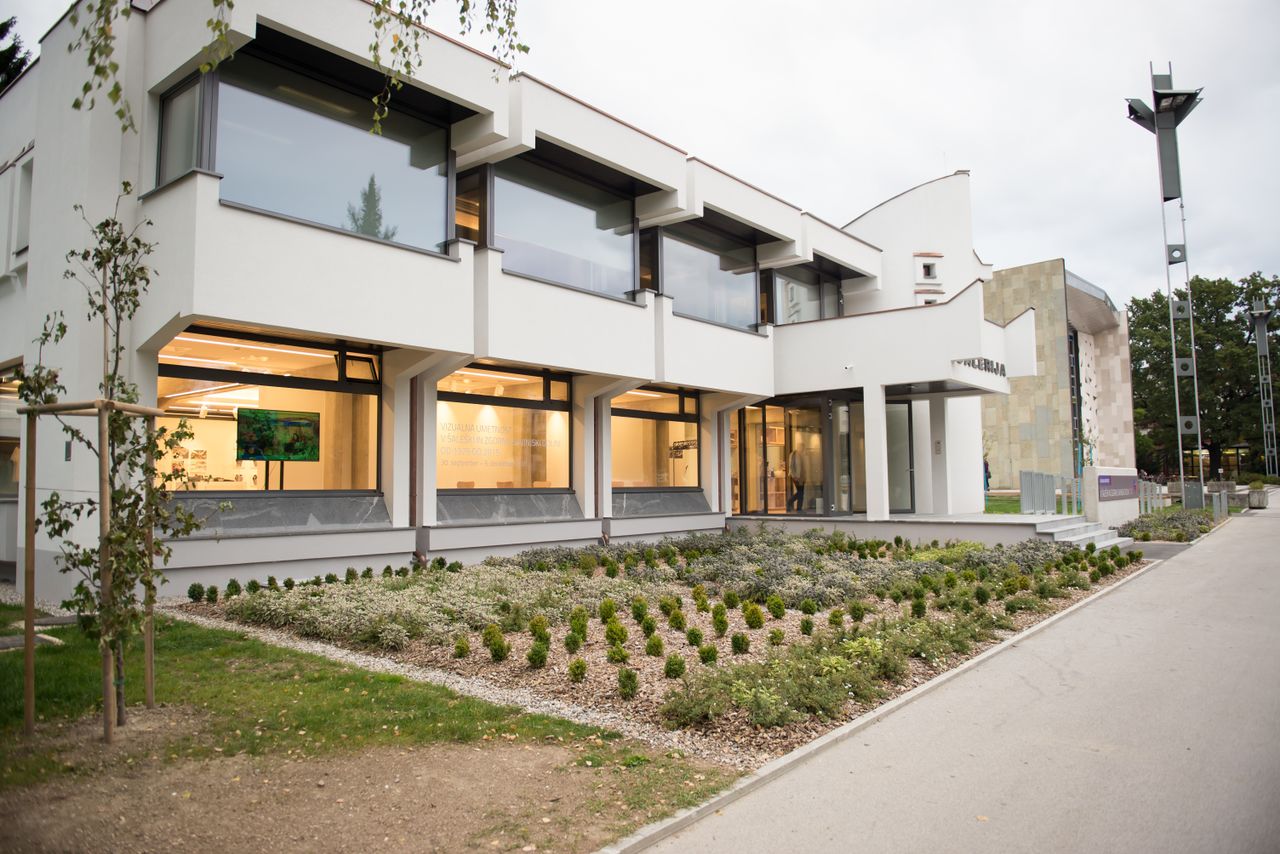 A modernist building of the Velenje Regional Gallery, designed in 1971 by Adi Miklavc, thoroughly renovated in 2015
A modernist building of the Velenje Regional Gallery, designed in 1971 by Adi Miklavc, thoroughly renovated in 2015
The Folk Museum Rogaška Slatina is made up of a curious and highly diverse collection of historic artefacts and stories, as gathered and curated by Nani Poljanec. Nani, a very colourful persona in his own right, has been working on this collection for the better part of his life and currently it is made up of more than 40 different sub-collections. Its three focal points, however, are the Karađorđević dynasty, local studies, and philography (the collecting of autographs, especially those of famous persons).
Since 2012 the better part of this collection is publicly displayed at Ana's Mansion (Anin Dvor), a newly built exhibition venue (that also holds a display of art graphics) in the spa town of Rogaška Slatina. The exhibition was enlarged and renovated in 2017.

 A concrete sculpture by Dragica Čadež Lapajne (SI), made in 1986 and standing in front of the Primary School Gustav Šilih in Maribor, 2008
A concrete sculpture by Dragica Čadež Lapajne (SI), made in 1986 and standing in front of the Primary School Gustav Šilih in Maribor, 2008
Forma Viva Open Air Sculpture Collection, Maribor is one of several in Slovenia which arose under the auspices of the International Symposia of Sculptors called Forma Viva, an innovative project conceptualised as a regular gathering of artists from all over the world. They were invited to create various, often monumental sculptures according to their particular vision and style. These works are then incorporated into publicly accessible collections that bear the name of Forma Viva as well.
Each of the venues of the Symposia chose a site-specific policy for the materials used. Maribor's Forma Viva was conceptualised as a distinctively urban project that was supposed to reflect the expanding urban fabric of Maribor. Correspondingly the works, dispersed throughout the city, are made of reinforced concrete.
 France Bevk Homestead, the attic in which Slovene writer France Bevk (1890–1970) wrote his first book as a 12-year-old boy, transformed into an exhibition room displaying documentation relating to the writer's life and work
France Bevk Homestead, the attic in which Slovene writer France Bevk (1890–1970) wrote his first book as a 12-year-old boy, transformed into an exhibition room displaying documentation relating to the writer's life and work
Famous Slovene writer, publicist, political and cultural worker France Bevk (1890–1970) was born at the Volar homestead in the village of Zakojca. He spent his childhood and early youth living on a slope of the Kojca mountain, above the Baška Valley.
The France Bevk homestead was opened to visitors in 1990 on the 100th anniversary of the writer's birth. It was established by the Idrija Municipal Museum which also houses France Bevk's Memorial Room, donated by his wife and transferred from Ljubljana to Idrija in 1971. His homestead in Zakojca is nevertheless managed by the Cerkno Museum.
The Franja Partisan Hospital at Dolenji Novaki near Cerkno is a cluster of functionally arranged Partisan hospital facilities located in the narrow, barely accessible Pasice Gorge, which is itself a natural attraction. The hospital complex comprises 14 wooden buildings and several small auxiliary facilities that were gradually established from December 1943 to May 1945.
The Franja Partisan Hospital is temporary closed due to storm damage in July 2023.
The Novo mesto Regional Office of the Institute for the Protection of Cultural Heritage of Slovenia, founded in 1980, is responsible for cultural heritage in the Dolenjska and Bela krajina regions, with cultural monuments declared of high importance by the state, among them the St. Nicolas Church in Novo mesto with famous altar painting by Jacopo Robusti Tintoretto (1518 - 1594), the Brežice Castle, the Partisan Baza 20 in Kočevski rog, the Ausperg Ironworks at Dvor near Žužemberk and Mithras temple at Rožanec near Črnomelj. Recent motorway building works have uncovered an archaeologically rich region, and archaeological excavations and research work are still under way at different sites. The office has its quarters, conservation and restoration workshop and depots in Grm Castle (16th – 18th Century) with stucco ceiling decoration and wall paintings in the tower room.
 The Grm Castle, built in 1586 by Krištof Mordax, combined its residential function with that of defence against the Turkish invaders; it was rebuilt in 1636.
The Grm Castle, built in 1586 by Krištof Mordax, combined its residential function with that of defence against the Turkish invaders; it was rebuilt in 1636.
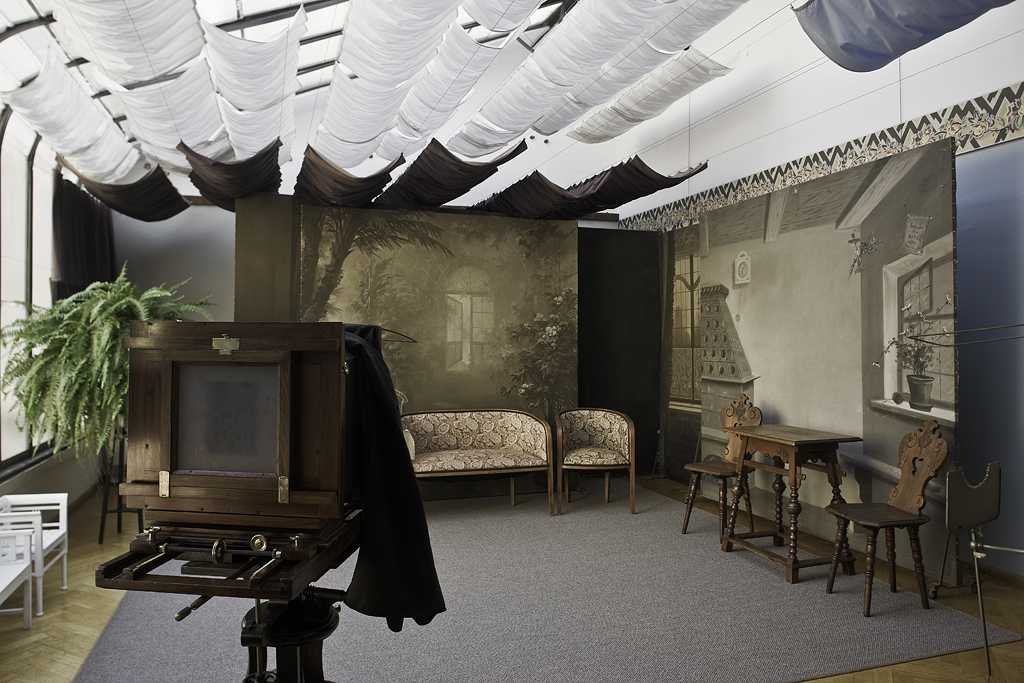 Josip Pelikan Photographic Studio, preserved studio the famous Slovene photographer Josip Pelikan (1885 - 1977), established as a museum in 1989, Celje. The museum display presents a special collection containing historic photographic equipment
Josip Pelikan Photographic Studio, preserved studio the famous Slovene photographer Josip Pelikan (1885 - 1977), established as a museum in 1989, Celje. The museum display presents a special collection containing historic photographic equipment
Josip Pelikan Photographic Studio, a branch of the Celje Museum of Recent History, was established as a museum exhibition in 1989. The studio is without a doubt one of the best preserved luxurious glass photographic ateliers in Europe with original equipment used by the famous Slovene photographer Josip Pelikan (1885–1977). The 19th-century glass photographic studio on the second floor makes daylight photography possible even today.
 Kobarid Museum seen from the street
Kobarid Museum seen from the street
Kobarid Museum is devoted to the Soča (Isonzo) Front of the First World War. The valley of Soča River saw no fewer than 12 battles between the Italians and the forces of the Austro-Hungarian empire between May 1915 and November 1917, making it a battlefield of extraordinary proportions, even for World War I. The exact death toll has never been established. While talk used to be of over a million, historians now say that at least 300,000 soldiers died in three years of fighting.
Established in 1990 in the Slovene town Kobarid (called Karfreit when part of the Austro-Hungarian empire, and Caporetto under the Italians) near the Italian border, the Kobarid Museum won the prestigious Council of Europe Museum Prize in 1993. The permanent exhibition is unique in that it does not favour any side in the war, there are just men fighting, losing lives and being mutilated under heavy fire or harsh weather conditions in a war where industry and money make a difference, not man power, courage or effort. It is a museum about war that leaves an impression of deep pacifism.

Located in the narrow valley beneath the Jelovica plateau, the town of Kropa has preserved the appearance of an old iron-making settlement and since 1953 has been protected as important state cultural monument. The Kropa Iron Forging Museum was established in 1952 as the first technical museum in situ. It was founded on the endeavours of locals and experts, especially Franjo Baš who was at that time director of the Technical Museum of Slovenia.
The Iron Forging Museum is located in the old 18th-century forging house known as Klinar House (a very well preserved mansion by a forge owner) and is nowadays administered by Radovljica Municipality Museums. It covers the technical and historical development of iron-working from iron ore to nail.
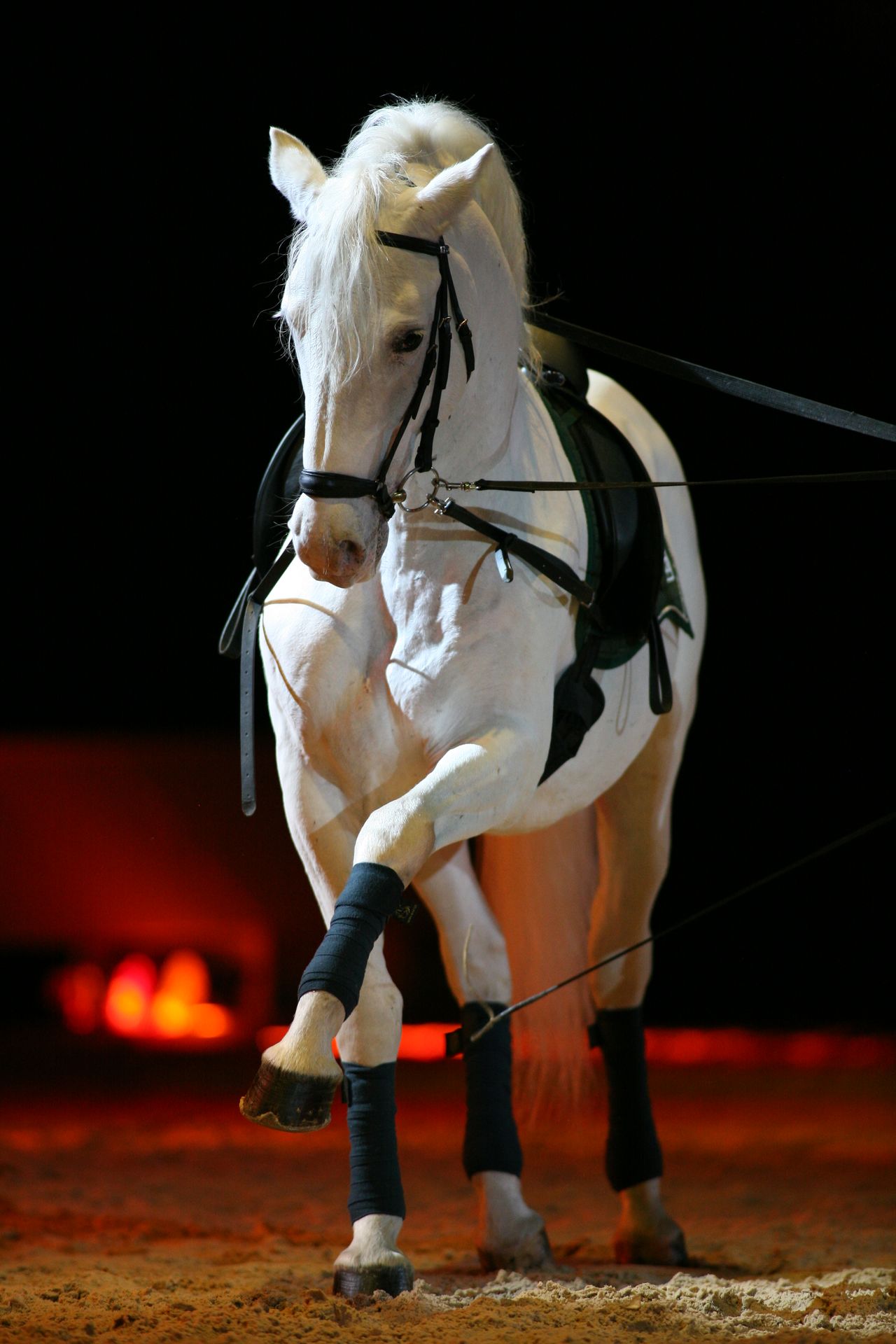 A Lipizzaner horse in a gait training session at Lipica Stud Farm, only stallions are trained for classical dressage and some of the best perform at the Spanish Riding School in Vienna
A Lipizzaner horse in a gait training session at Lipica Stud Farm, only stallions are trained for classical dressage and some of the best perform at the Spanish Riding School in Vienna
Lipica Stud Farm is home to one of the world's most famous breed of horses, the Lippizaner. Founded by Archduke Charles of Austria in 1580, the farm has continuously bred the sturdy white horses for over four centuries and some of the best of these perform at the Spanish Riding School in Vienna.
The farm, extending over 311 hectares in the Karst countryside, was proclaimed a place of special cultural heritage in 1996, and has since that time been state-owned and managed by the Republic of Slovenia. At present the farm is home to around 350 white horses. The traditional Lipica Days are organised at the end of September. Museum Lipikum, the Lipizzaner Museum opened in Lipica in 2011.
 Loka Castle at night, 2007
Loka Castle at night, 2007
In the 12th century on the hills above Škofja Loka stood three fortifications: the Upper Tower on Krancelj; the Lower Fort (nider vest); and the Loka Castle, a residence of Freising Bishops, built at the brink of a natural terrace. The castle is first mentioned in 1202 as castrum firmissimum, although today's building dates from the 16th century. The castle was rebuilt in 1691 after an earthquake and in 1716.

The Louis Adamič Memorial Room is housed in Praproče, the birthplace of Louis Adamič (1898–1951), a Slovene writer who spent most of his life in the USA after emigrating there in 1913 at the age of 14. Known in the United States as Adamic (a-dam'ik), his literature dealt with the social and political issues of both countries (for example, Dynamite, The Native's Return, The Eagle and the Roots).
The collections of Adamič's legacy are dispersed throughout various archives in Slovenia and the USA. The most important is the one at Princeton University (books from his own library, manuscripts and correspondence, clippings). In Slovenia, the memorial room is placed in the tower of the country mansion in Praproče, where Adamič spent his childhood.
 Interior and exterior views of old BarliÄ homestead that houses the memorial room, established 1985, commemorating the founding of the Communist Party of Slovenia, Äebine 1937
Interior and exterior views of old BarliÄ homestead that houses the memorial room, established 1985, commemorating the founding of the Communist Party of Slovenia, Äebine 1937
Located in a substantially altered old Barlič homestead, this memorial room commemorates the Founding Congress of the Communist Party of Slovenia, which was held here in 1937. The room was set up in 1985 and contains original period furniture, and two panels illustrate the events which occurred here.
The Memorial Room at Topolšica, some 12 kilometres from Velenje, commemorates the unconditional surrender of German forces in south-eastern Europe at the end of the Second World War. On 9 May 1945 General Alexander Löhr, Commander of the E Group of armed forces and Commander for the South East, signed an agreement here surrendering his units unconditionally. With this document the Second World War ended for Slovenians. Behind the glass wall is a reconstruction of the signing of the capitulation that was one of the most important events on our territory during the Second World War. Visitors can also view a documentary film on the event. One of the main curiosities of the collection is also General Löhr's gun, which was confiscated only a few days after the signing of the capitulation by Ivan Dolničar. The surrender, signed in the health resort of Topolšica, was one of four partial surrenders of the German army at the end of the Second World War.
The memorial room is managed by Velenje Museum and can be visited around the clock every day of the year for free in a park of Topolšica Health Resort.
 General Rudolf Maister-Vojanov (1874–1934)
General Rudolf Maister-Vojanov (1874–1934)
This memorial room in Voličina is dedicated to soldier and poet General Rudolf Maister-Vojanov (1874–1934), who towards the end of World War I organised local volunteers and seized control of the city of Maribor and the surrounding region of Lower Styria, thus securing it for the newly-formed Kingdom of Serbs, Croats and Slovenes.
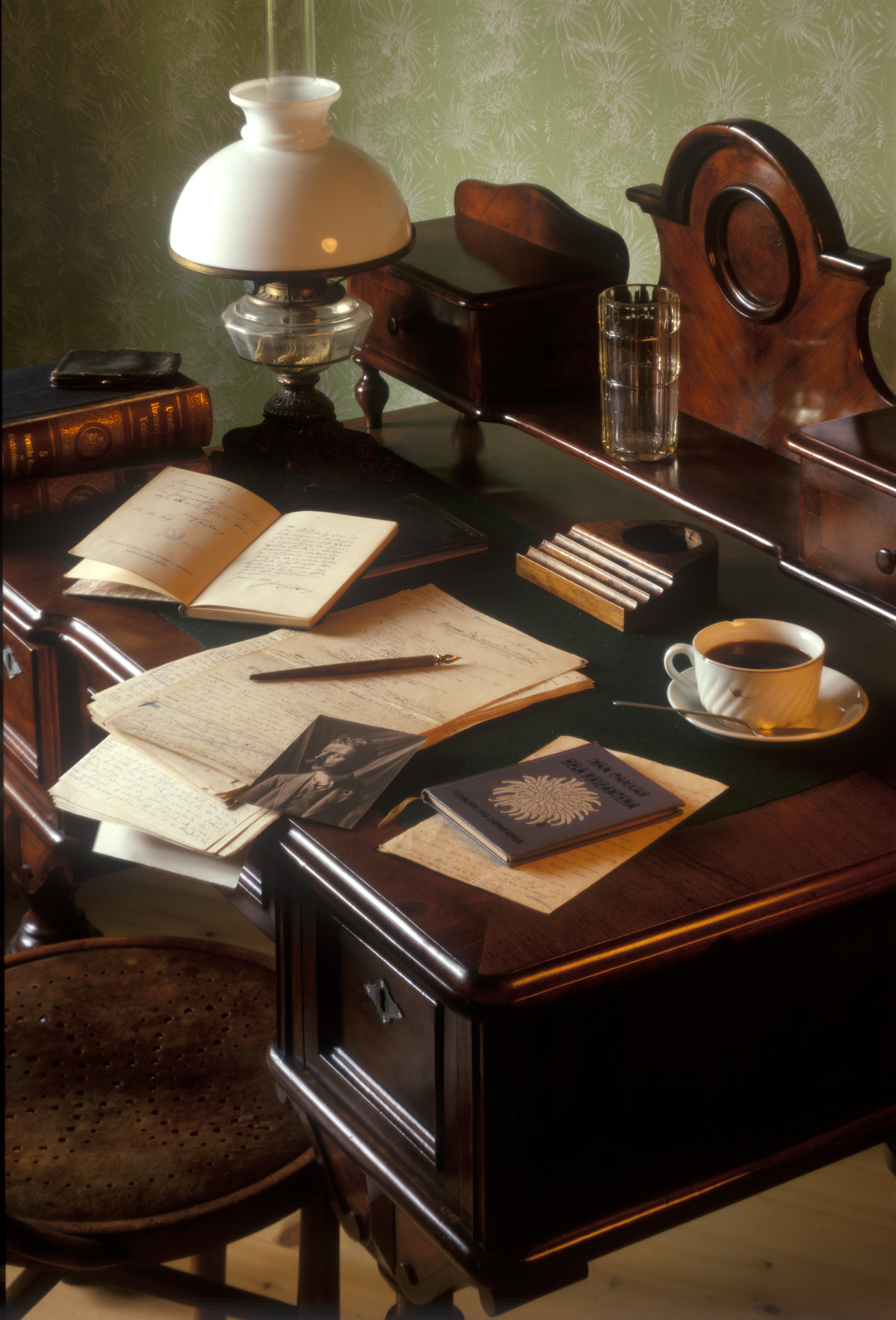 Memorial Room of Writer Ivan Cankar, 2009
Memorial Room of Writer Ivan Cankar, 2009
The Memorial Room of Writer Ivan Cankar (1876–1918) is a reconstruction of his original room with objects dating from his lifetime and several of his personal belongings as well as some of Cankar's first prints and translations of his work. The modernist poet, writer and playwright Ivan Cankar lived in the inn on the top of the Rožnik hill in Ljubljana from 1910 to 1917. On the 30th anniversary of his death the location was renamed Cankarjev vrh (Cankar's Summit) and the City Museum of Ljubljana opened a public memorial room in the adjacent building (1948).
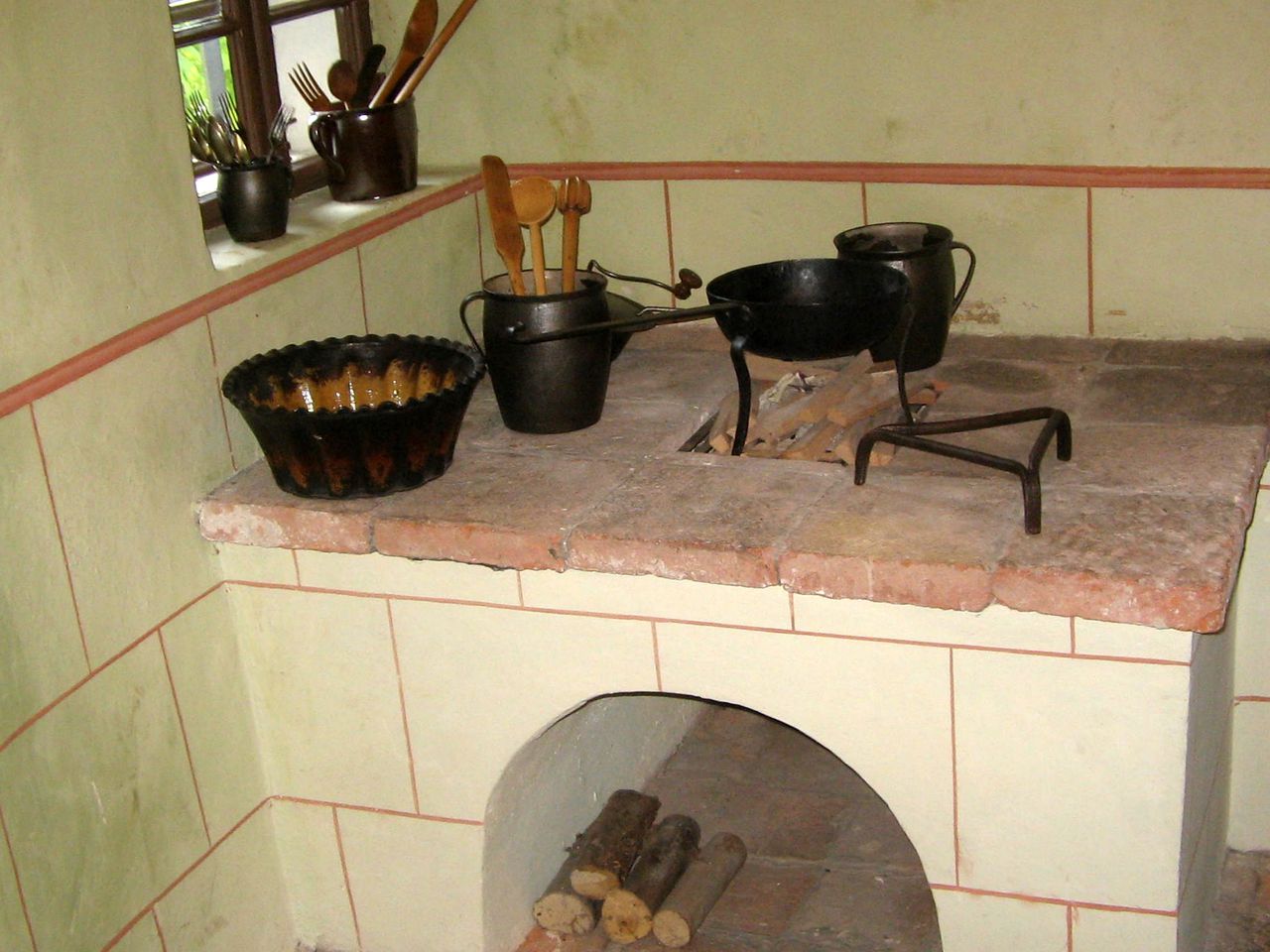
The Miner's House and its ethnological collection in Idrija shows the household and living conditions of miners and their families in the past. Men in Idrija worked almost exclusively as miners in the Idrija Mercury Mine; women were housewives, taking care of the children and trying to earn additional money with various domestic jobs, typically from knitting and making Idrija bobbin-lace. Most families could not afford to have their own house but were usually tenants in private homes and, after 1870, resided in apartment blocks called prhauzi.
The Miner's House was built at the end of the 18th century and has preserved the main features of typical Idrija architecture. After undergoing extensive renovation in the 1990s, the house is today protected as a cultural monument and administered by the Idrija Municipal Museum. The furniture and tools of the household date back to the first half of the 20th century.
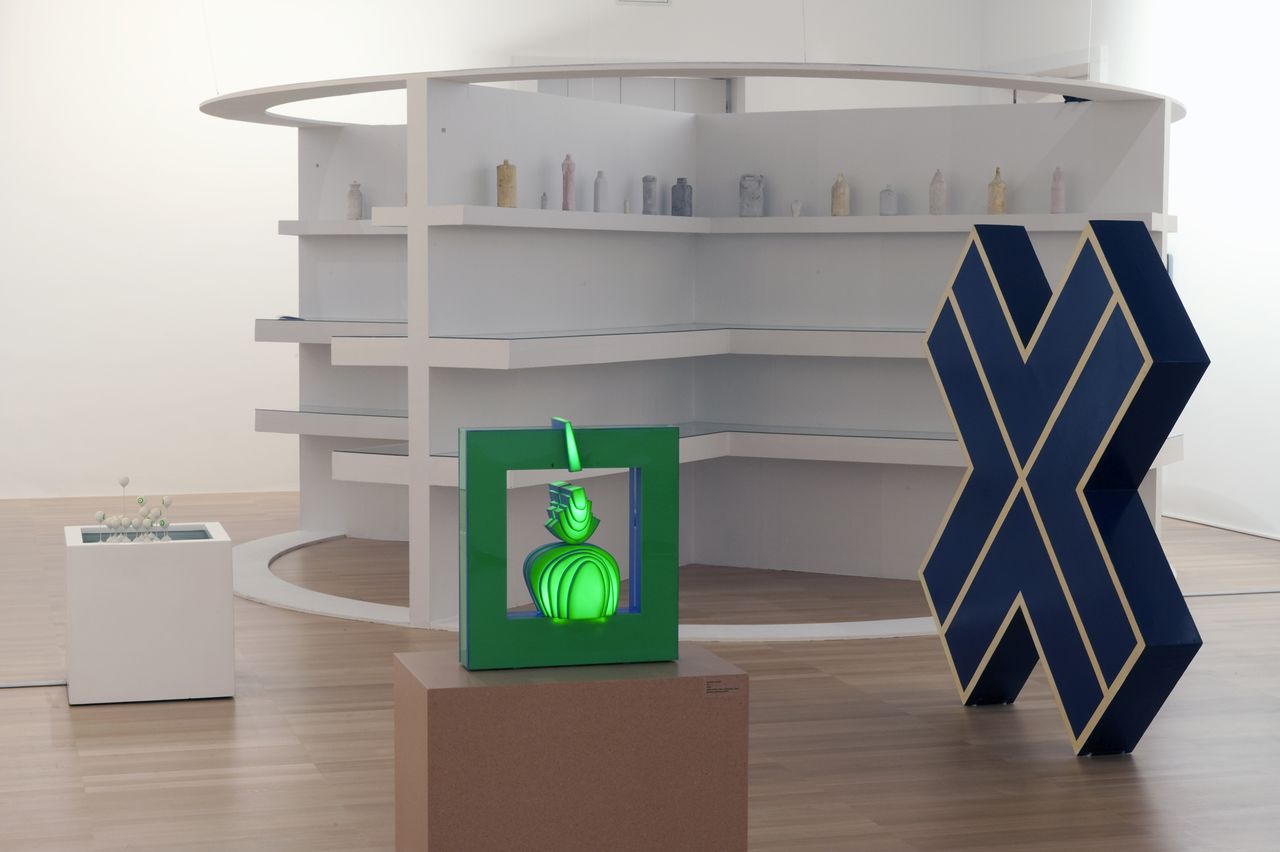 20th Century / Continuities and Ruptures, a permanent display of the selected works from the Moderna galerija collection, 2011
20th Century / Continuities and Ruptures, a permanent display of the selected works from the Moderna galerija collection, 2011
Up to 2011 the Moderna galerija (MG), established in 1948 in Ljubljana, has been the central national institution for modern and contemporary art. Since November 2011 the national institution consists of two venues - Moderna galerija (MG) and the Museum of Contemporary Art Metelkova (MSUM) that opened in a new space in the cultural quarter at Metelkova. The Moderna galerija / Museum of Modern Art, Ljubljana plus Museum of Contemporary Art Metelkova has also an abbreviated form MG+MSUM standing for Moderna galerija plus Muzej sodobne umetnosti.
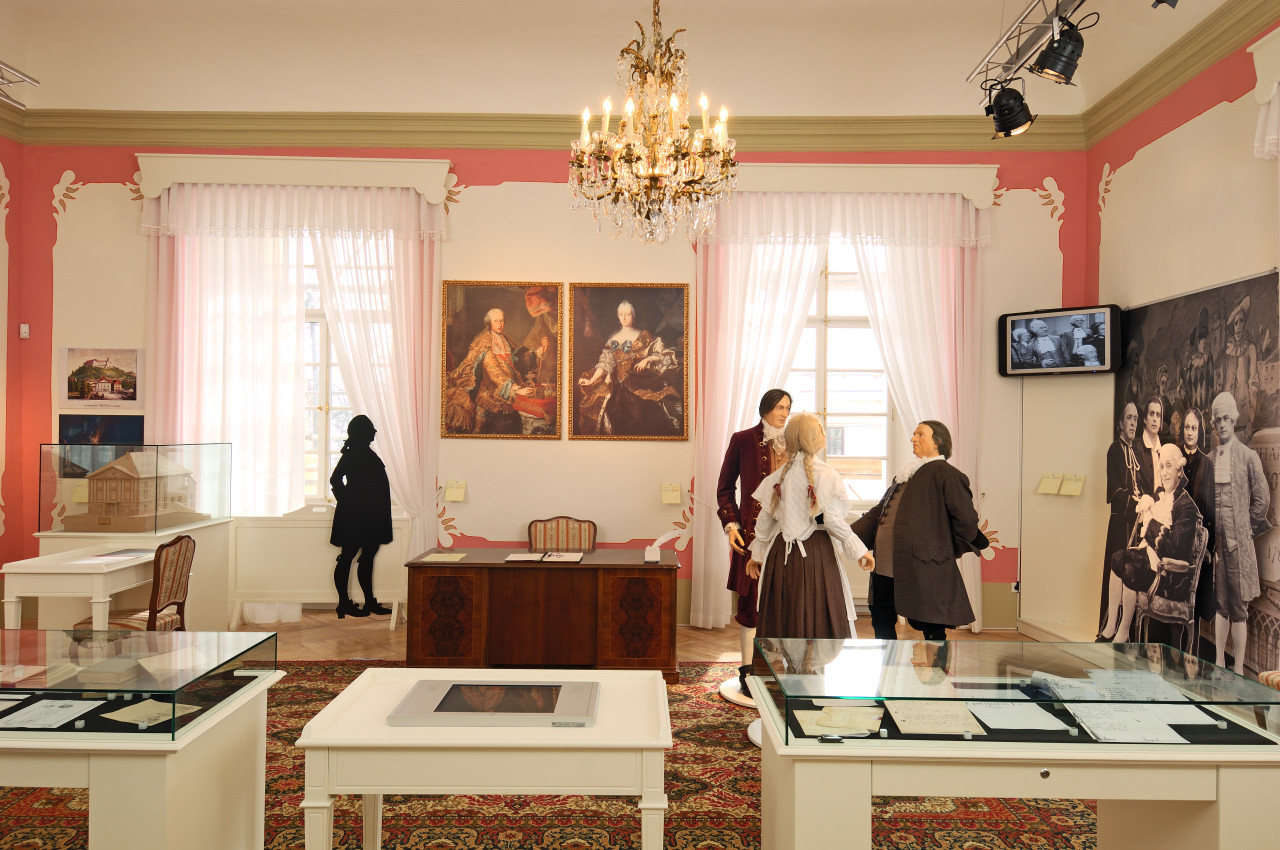 Linhart's hall at the Municipal Museum of Radovljica
Linhart's hall at the Municipal Museum of Radovljica
The Municipal Museum of Radovljica, the youngest unit within the public institute of Radovljica Municipality Museums is located in the historic centre of Radovljica on the first floor of the Baroque Radovljica Mansion (the building also houses the Museum of Apiculture). The museum features an exhibition on the pioneer Slovene dramatist, historian and pedagogue Anton Tomaž Linhart, originally installed in 1974.

Opened in 1971, the Museum of Alpine Dairy Farming, Stara Fužina is located in Triglav National Park in an abandoned village cheese-dairy Pleskarjeva bajta of 1883 where cheese was still made as late as 1967. The museum, renovated and expanded in 1990, shows life and work on the alpine meadows of Bohinj displayed with artefacts and photography.
The Museum of Apiculture, Radovljica, located in the Baroque Radovljica Mansion in the historic centre of Radovljica (together with the Municipal Museum of Radovljica), was founded in 1959 by the executive committee of the Beekeepers' Association of Slovenia in response to an appeal in the journal Slovenski čebelar (Slovene Beekeeper) to collect more material on the ancient practice of beekeeping. The museum was incorporated into the Radovljica Municipality Museums in 1963, thoroughly renovated in 1973, and again from 1996 to 2000.
 The bust of Anton Janša (1734-1773), the beekeeping mentor, at the Museum of Apiculture, Radovljica
The bust of Anton Janša (1734-1773), the beekeeping mentor, at the Museum of Apiculture, Radovljica
 Interior of the Museum of Hostages, Begunje na Gorenjskem
Interior of the Museum of Hostages, Begunje na Gorenjskem
The Museum of Hostages in Begunje na Gorenjskem was founded by the Municipality of Radovljica in 1961 and incorporated into the Radovljica Municipality Museums in 1963. It is housed in the northwest wing of the Katzenstein mansion, where the cells of those condemned to death were located during the Second World War. The mansion, with its interesting history from the 14th century onwards, is now a psychiatric hospital. The museum is declared a cultural monument of national importance together with the Katzenstein mansion, the memorial park in Draga Valley, the avenue lined with chestnut trees, and the pavilions Jožamurka and Brezjanka designed by Slovenian architect Jože Plečnik.
 Museum of Post and Telecommunications located in Polhov Gradec mansion as separate branch of the Technical Museum of Slovenia
Museum of Post and Telecommunications located in Polhov Gradec mansion as separate branch of the Technical Museum of Slovenia
The Museum of Post and Telecommunications, which had been housed in Škofja Loka since 1985, was moved in June 2008 to Polhov Gradec mansion. The renewed museum collection was co-established by Pošta Slovenia and Telekom Slovenia, while it remains a separate branch of the Technical Museum of Slovenia. The museum includes displays of national postal history and the history of telecommunications. The museum also houses a collection of stamps. The majority of the exhibited technical exponents are still functioning. Visitors with minor technical knowledge can also become acquainted with the operational basics of various electrical, optical and acoustic appliances used for transmitting information.
 Museum of Puppetry at Ljubljana Castle, 2015
Museum of Puppetry at Ljubljana Castle, 2015
Opened in 2015, the Museum of Puppetry is a joint project of the Ljubljana Puppet Theatre and the Ljubljanski grad Public Institute, supported by the Municipality of Ljubljana. The permanent exhibition Images of Slovenian Puppetry Art, 1910-1990 displays the numerous forms, contexts and techniques of puppet shows, featuring both children's plays as well as experimental theatre performances.
The establishment of the museum presents a pioneering work for Slovenian puppet arts, as the material history of Slovenian puppetry has never before been systematically researched, not to mention restored and exhibited. With this in mind, one of the primary objectives of the museum is to create the conditions for the proper care and long-term preservation of Slovenian puppetry culture heritage.
The history of the Museum of Slovene Police dates back to the year 1920. In 1971 its first professional curator, art historian Biserka Debeljak developed an intriguing display based on the methodologies of dealing with different aspects of crime in the society. Thus the museum is often considered as the Museum of Criminalistics. The Museum of Slovene Police is a member of the Association of Slovene Museums.
 The Museum of Slovene Police installation in Tacen, 2008
The Museum of Slovene Police installation in Tacen, 2008
 An opening ceremony of the Izgnanci exhibition at the National Museum of Contemporary History, Brestanica Unit at Rajhenburg Castle, 2014
An opening ceremony of the Izgnanci exhibition at the National Museum of Contemporary History, Brestanica Unit at Rajhenburg Castle, 2014
The Brestanica Unit of the National Museum of Contemporary History is housed at Rajhenburg Castle in Brestanica, one of the oldest medieval castles in Slovenia. The permanent exhibitions, however, are dedicated to the (mis)usage of the castle premises in the modern times. From 1884 till 1941 it was occupied by the contemplative Trappist Order, which brought progress to the Posavje region. They were expelled by the Nazis who converted the castle into a camp for deporting Slovenes. During the course of World War II around 45,000 Slovenes were sent into exile from here. After World War II the castle continued to function as a prison, but in 1968 it was converted into a museum. Currently it features a re-staged permanent exhibition on the Trappists from Rajhenburg. A new permanent exhibition dedicated to the internment and political prisoners was opened in 2014.
Oplen House is a traditional early 20th-century Bohinj farmhouse made of wood and stone, renovated in period style with authentic furnishings to serve as a museum of domestic culture of the people living in the valleys around Bohinj Lake. The house was renovated by donations from locals, the Institute for the Protection of Cultural Heritage of Slovenia and furnished in collaboration with the Gorenjska Museum, which also contributed some of the exhibits. The museum opened to the public in 1991, and has been managed since 1997 by the Gorenjska Museum.

Since 1995, Ormož Castle, first mentioned in 1278, has been a centre for contemporary cultural developments which houses the Franc Ksaver Meško Library, part of the administration of the Ormož unit of the Ptuj – Ormož Regional Museum. There is also a Castle Gallery featuring contemporary art exhibitions. Premises in the castle have also been given to the Ormož brass band.
In 2011 the award-winning renovation of the Grajska pristava (castle's outhouse) was completed, led by the Arrea Architecture bureau. It houses the Ormož Music School, a new multipurpose hall, and the ethnological and archaeological museum collections, and has turned the Ormož Castle into an outstanding cultural centre.
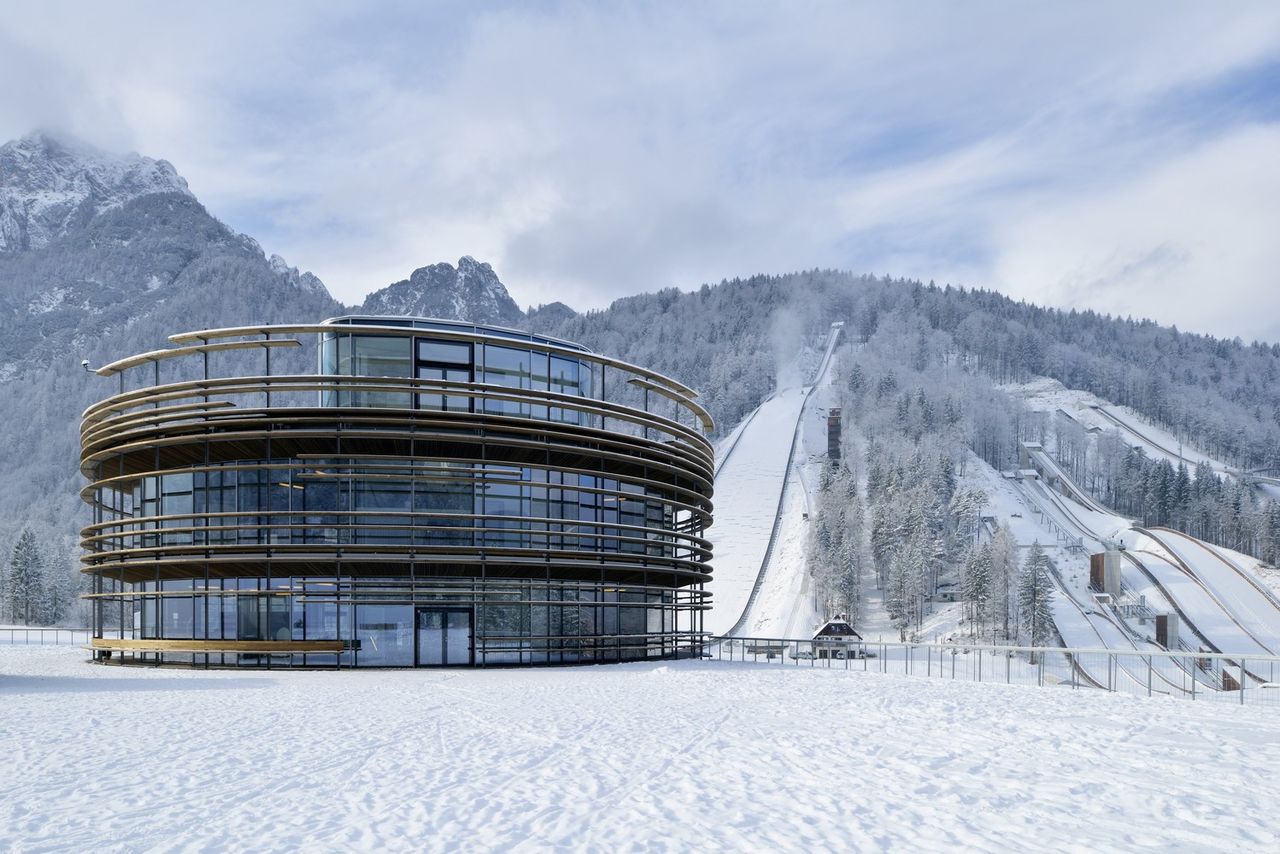 The pavilion and the ski fly hills at the Nordic Centre Planica. The pavilion was conceived by STVAR architects, 2016.
The pavilion and the ski fly hills at the Nordic Centre Planica. The pavilion was conceived by STVAR architects, 2016.
The Planica Museum is dedicated to the history of ski jumping and flying in Planica, an alpine valley in northwestern Slovenia. Historically, this valley has been one of the prime sites for the development of ski flying as a sports discipline of its own, and consequently, the museum also presents the wider history of ski jumping as such. Nevertheless, its main focus is to present and develop both the cultural as well as the technical heritage of almost a century of ski jumping in Planica.
At the end of 2015, the Nordic Centre Planica was completed and inaugurated. It is a modern Nordic skiing complex that boasts eight newly built or renovated ski jumping and flying hills and caters to cross-country skiing and various summer activities. The three bureaus that handled the architectural dimensions of the project are: A.biro (ski jumps and bridges), STVAR Architects (service and performance buildings, pavilion) and Studio AKKA (landscape, including the lay-out of infrastructure and cross country lanes).
Set in a newly constructed pavilion as a part of the Nordic skiing complex called the Nordic Centre Planica, the Planica Museum opened its doors in 2016.
The collection is located at the Plečnik House in Trnovo, where Jože Plečnik lived from 1921 until his death in 1957. Plečnik's original work and furniture, his library, his drawing tools, and his personal belongings are preserved here, together with a large archive of sketches, plans, photographs, and models made of wood, clay, and plaster, as well as Plečnik's correspondence and his student work. The main part of the collection is on display in the cylindrical annex of the house, constructed between 1923 and 1925 by the architect himself.
 The architect Jože Plečnik moved to a single-storey house at Karunova Street 4 in Ljubljana's Trnovo district in 1921, and extended it with a cylindrical tower in 1924. Plečnik House exterior, renovated in 2015. Photo by Andrej Peunik/Museum and Galleries of ljubljana
The architect Jože Plečnik moved to a single-storey house at Karunova Street 4 in Ljubljana's Trnovo district in 1921, and extended it with a cylindrical tower in 1924. Plečnik House exterior, renovated in 2015. Photo by Andrej Peunik/Museum and Galleries of ljubljana
Now a small yet highly intriguing museum, the Plečnik House is the former abode of Jože Plečnik (1872–1957), one of the most important and certainly the most well known Slovene architect. As of 1974 devoted to this European architectural great, the museum houses the collection of Plečnik's personal artefacts as well as (since 2015) a study centre, a permanent exhibition on the architect's life and work and a space for temporary exhibitions related to Plečnik's work, his contemporaries or his influence on today's creative sector. However, the house itself is a testament in its own right, having been used as some sort of a prototype ground by its illustrious owner.
A thoroughly renovated complex of the two houses, a cylindrical tower and an adjacent garden with a lapidarium, together with the entire inventory of furniture and other objects used by Plečnik, is since 2010 managed by the Museum and Galleries of Ljubljana. Plečnik House was among the recipients of the European Union's Cultural Heritage Award / Europa Nostra for 2018. It won the award in the category of Education, training and raising awareness.

After its closure in 2004, the Mežica lead and zinc mine was turned into Podzemlje Pece, Tourist Mine and Museum which was nominated for the European Museum of the Year Award 2007. First notes about lead ore in this area are from 1424 and the first written sources about mining under the Mount Peca are from 1665. The old mine administration building of 1927, located in front of the mine entrance, has been converted into a museum with a number of collections (a mining exhibition and the collection of Maks Kunc, miner and photographer).

One of the most picturesque castles in Slovenia, Predjama Castle is built into an overhanging rock in front of a karst cave hall that is connected with a cave system underneath the castle. It is situated just a a few kilometres from the entrance to the Postojna Cave. The castle is now a museum on five floors that shows the life in the 16th century, with an armoury, dungeon, halls, living quarters and other castle facilities. Interesting is the dialogue between man-made architecture and natural structures that combine into the castle's fortification system.
The Railway Museum of Slovenske železnice displays the railway heritage of Slovenia, as gathered and preserved by the Slovene Railways company and its predecessors. Featuring still functional old steam locomotives set in a former locomotive shed, this is a small, yet very curiously laid-out and comprehensive, museum.
The museum is divided into two sections: a collection of vehicles (steam locomotives, coaches, wagons and other historic rolling stock) and a permanent exhibition of old apparatuses, tools and other items of heritage relating to various fields of railway history and technology. Thematic temporary exhibitions are held here, as are occasional related events. Additionally, regular rides with historic trains are also a part of this enterprise.
 One of the steam locomotives in the Railway Museum of Slovenske železnice collection of vehicles, 2012
One of the steam locomotives in the Railway Museum of Slovenske železnice collection of vehicles, 2012
 Exterior of Sergej Mašera Maritime Museum, Piran, 2020.
Exterior of Sergej Mašera Maritime Museum, Piran, 2020.
The first collections on the history of seafaring in Piran-Pirano were presented to the public back in 1954, when the Piran Municipal Museum first opened its doors. It was renamed as the Sergej Mašera Maritime Museum in 1967, and since then the museum has conducted extensive research into Slovene maritime history and maritime archaeology. It has thus gathered an important collection of tangible and intangible cultural heritage connected with either seafaring (from its technological and ethnological dimensions to the related artistic work) or with maritime economic branches like salt-making, fishing and naval trade.
The bulk of the museum collections is housed in the 19th-century Gabrielli Palace, but quite a few of its collections are also presented elsewhere.

The Slovenian Alpine Museum dedicated to mountaineering in Slovenia opened in August 2010 at the entrance to the Vrata Valley in the Triglav National Park. The new multifunctional edifice by the architects Boris Leskovec, Alja Vehovec, and Rok Kajtna hosts a permanent collection (previously displayed as a part of the Triglav Museum Collection), a specialised library, a historic mountain bivouac (transformed into a so-called escape room), temporary exhibitions, lectures, screenings, and presentations of Slovene and international mountaineering achievements. The Slovenian Alpine Museum also serves as an information point where visitors to the museum can book guided mountaineering trips in the wider Alpine area.

The earliest record of Snežnik Castle dates from 1269 when it was owned by the patriarchs of Aquileia. The castle lies on a strategic site, on the edge of the Lož Valley under the Snežnik mountains surrounded by a beautiful park and vast forests with diverse and rich flora and fauna including big game ranging from bears, boars, wolves and lynxes, to wild fowl and deer, and was always favourite hunting residence. Throughout the centuries the castle has changed owners many times, but in 1853 the castle and associated forests of Snežnik were bought by German Prince Otto Viktor Schönburg-Waldenburg, who gave it to his third son Georg. Thereafter it remained in the Schönburg-Waldenburg family until 1945. The last caretaker Leon Schauta saved Snežnik Castle from destruction after the Second World War by keeping good relations with the locals before and after the war. Restoration began in the 1960s and the castle opened to the public in 1970/71. In 1983 two additional exhibition rooms were opened. After a restoration completed in 2008, the romantic state-owned castle came under the administration of the National Museum of Slovenia and is the only Slovene Castle with genuine furnished interiors.
Since 2014 the Floating Castle Festival has embedded into the picturesque surroundings of the castle the late summer "folk-puppet-music-theatre site-specific event".

With the exception of the wagon and carriage collection, the Soteska open-storage depot encompasses a collection of vehicles that as a whole do not qualify as a museum collection. The vehicle collection is constantly complemented and rotated. When the project for a museum exhibition addressing the whole history of road transport in Slovenia can finally be realised, the most distinguished examples of wagons and carriages will be moved to Bistra, making way for some other vehicles from the Bistra Museum or Borovnica Open Storage Depot. In the future a more detailed presentation of the wagons and carriages collection together with their historical development is planned.
 The old pot, Stari Pisker Prison, was a Minorite monastery until the 19th century when it became a prison, used by German forces in WWII, established as a war memorial in 1965, administered by Celje Museum of Recent History
The old pot, Stari Pisker Prison, was a Minorite monastery until the 19th century when it became a prison, used by German forces in WWII, established as a war memorial in 1965, administered by Celje Museum of Recent History
Stari pisker ("Old Pot") is a memorial site to victims of Nazi violence. The site is administered as a dislocated permanent exhibition of the Celje Museum of Recent History, which holds torture and questioning devices and collection of moving farewell letters written by war prisoners held in the Stari pisker who had learnt they would soon be executed.







